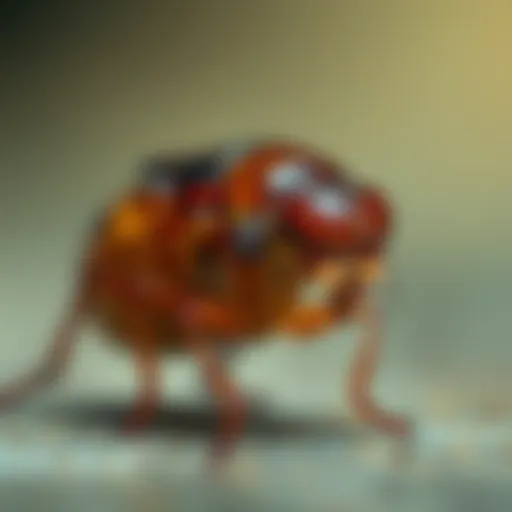Essential Nutrition for Adult Pugs: A Complete Guide


Intro
Adult pugs have specific dietary needs that are crucial to their health and well-being. This guide focuses on understanding these needs, ensuring that pug owners can provide the best nutrition for their beloved pets. The unique physiology of pugs—combined with their tendencies toward obesity—makes it imperative to tailor their feeding regimen with precision. By recognizing the essential nutrients they require, the types of food available, and the significance of portion control, owners can greatly influence their pugs' quality of life.
Animal Overview
Common Name and Scientific Classification
The pug, known scientifically as Canis lupus familiaris, is a breed of dog characterized by its small size and distinctive facial features. Pugs belong to the toy group and are recognized by organizations such as the American Kennel Club and the Fédération Cynologique Internationale.
Physical Characteristics
Pugs are known for their compact frames, with an average weight ranging from 14 to 18 pounds. Their short, curly tails and wrinkled faces are defining attributes. The breed has a square body shape with a broad chest, and their coat is smooth and can come in various colors, including fawn and black.
Habitat and Distribution
Pugs are adaptable and can thrive in various living conditions, from apartments to larger homes. Originally bred in China, they have since become popular worldwide. Their small size makes them suitable for urban living, but they still require regular exercise to maintain their health.
Nutritional Needs of Adult Pugs
Understanding the nutritional needs of adult pugs is vital. They require a balanced diet containing essential nutrients, including:
- Proteins: High-quality proteins from sources such as chicken, beef, and fish are crucial for muscle maintenance.
- Fats: Healthy fats support skin health and energy levels. Omega-3 and Omega-6 fatty acids are beneficial.
- Carbohydrates: Whole grains, such as brown rice and oats, can supply energy and assist digestion.
- Vitamins and Minerals: Vitamins A, D, E, and minerals like calcium and phosphorus should be included for overall health.
Pugs may face dietary restrictions due to common health issues, such as obesity or food allergies. This calls for customized feeding plans that suit their individual conditions.
Food Types
When providing food for adult pugs, several options are available:
- Dry Kibble: Convenient and helps maintain dental health.
- Wet Food: Palatable and has higher moisture content.
- Raw Diet: Some owners prefer this option, but it requires careful planning to ensure nutritional balance.
- Homemade Meals: Consulting a veterinarian or a pet nutritionist is essential when preparing food at home.
Portion Control and Feeding Schedule
Effective portion control is crucial. Pugs have a propensity to overeat, leading to obesity. A general guideline for daily food intake is about 1/2 to 1 cup of food, split into two meals. Monitoring their weight regularly and adjusting feeding quantities accordingly is advisable.
Proper nutrition, along with a suitable exercise regime, can greatly enhance the health and longevity of pugs.
Feeding schedules should also align with the dog's lifestyle. Regular meal times help in digestion and prevent begging behavior. It is essential to maintain consistency in both timing and quantity of food to promote a healthy routine.
Finale
In summary, understanding the dietary needs of adult pugs is paramount for their health. Selecting the right food types, keeping a close eye on portion sizes, and establishing a precise feeding schedule can vastly improve their quality of life. Pug owners who engage with these practices are likely to see their pets thriving and enjoying a longer lifespan.
Understanding the Pug Breed
Understanding the pug breed is crucial when discussing their food needs. Pugs are unique dogs with specific biology that influences their dietary requirements. Their stature, coat type, and temperament all tie back into their nutritional necessities. A well-informed owner can more effectively cater to a pug's needs, ensuring proper health and well-being through diet.


History and Origin of Pugs
The pug has a rich history that dates back over 2,000 years. Originating from China, they were bred as companion animals for royalty. Their lineage is thought to link back to the ancient short-haired dog breeds of the region. Pugs gained popularity in Europe during the 16th century, especially in Holland and France. Their affectionate and sociable nature made them quite appealing to European nobility.
Pugs were once considered a symbol of good fortune in China. They were often treated with great care, and it was common for these dogs to live luxurious lifestyles. As they migrated to different continents, their characteristics remained attractive to many, leading to the breed's widespread popularity today. Understanding their origin helps owners appreciate the gradual evolution of their needs, especially concerning nutrition and care.
Physical Characteristics of Adult Pugs
Adult pugs have distinct physical attributes that influence their health and dietary needs. They are typically small, weighing between 14 to 18 pounds. Their compact, muscular frame, along with a typical height of about 10 to 13 inches, contributes to their unique appearance. Pugs have a wrinkled face, large round eyes, and a short muzzle, which can lead to certain health vulnerabilities, particularly with respiratory issues.
The coat is predominantly short and smooth, and it can come in various colors, mainly fawn and black. The structure of a pug, particularly their skeleton, encourages a sedentary lifestyle. This sedentary nature can lead to obesity if diets are not appropriately managed. Such physical traits make it essential for pug owners to monitor their diet closely to ensure optimal health and weight management.
Common Health Concerns in Pugs
Pugs are prone to several health issues that can significantly impact their quality of life. Their brachycephalic structure—having short muzzles—leads to breathing problems, especially in hot or humid weather. Respiratory issues can complicate their dietary needs, often requiring a consideration for dog foods that are easy to digest and manage.
Additionally, obesity is a common concern linked with poor diet and lifestyle habits. Pugs may overeat, especially if given the opportunity, so portion control is vital. Other prevalent health issues include hip dysplasia and eye conditions such as corneal ulcers and progressive retinal atrophy.
"Understanding the health risks associated with pugs will guide owners in making informed dietary choices that promote longevity and health."
Overall, being aware of these characteristics and health concerns equips pug owners with the knowledge required to provide the best care, ensuring a proper diet suited to their distinctive needs.
Nutritional Requirements of Adult Pugs
Understanding the nutritional requirements of adult pugs is essential. Pugs have specific dietary needs due to their unique physiology. A balanced diet can improve their overall health, manage their weight, and reduce the risk of related health issues. Proper nutrition contributes significantly to the longevity and quality of life for pugs. Owners must consider key nutritional elements like protein, carbohydrates, fats, vitamins, and minerals to keep their pugs vibrant and active.
Protein Requirements
Protein is a primary building block for the body. For adult pugs, protein is necessary for maintaining muscle mass, repairing tissues, and supporting immune function. The quality of protein matters more than the quantity. Pugs require animal-based proteins, as these sources contain essential amino acids that are vital for their health. Sources such as chicken, beef, fish, and eggs are excellent choices. A good rule of thumb is that protein should constitute about 20-30% of their diet. Therefore, examining labels for meat content in commercial dog food is crucial.
Carbohydrates for Energy
Carbohydrates provide energy. They are important in a pug's diet but should be balanced with other nutrients. Pugs are often less active than other breeds, meaning they do not require as many carbs as more energetic dogs. Complex carbohydrates, such as brown rice, sweet potatoes, and peas, are beneficial. These sources not only supply energy but also offer digestive fiber, promoting gut health. Aim for carbohydrates to make up roughly 30-50% of their food, adjusting according to activity levels.
Fats and Fatty Acids
Fats serve multiple roles. They are a concentrated source of energy. Fats also help in absorbing vitamins and maintaining healthy skin and coat. For adult pugs, healthy fat sources like fish oil and flaxseed can provide omega-3 and omega-6 fatty acids. These are crucial for reducing inflammation and improving overall well-being. Fat content should generally be around 10-15% of the diet, depending on age and activity level. Monitoring fat intake is important as pugs can easily gain weight.
Essential Vitamins and Minerals
Vitamins and minerals are vital for various bodily functions. Adult pugs need a wide range of micronutrients to support immune function, bone health, and metabolic processes. Key vitamins include vitamins A, D, E, and B-complex. Minerals like calcium and phosphorus support bone strength. A balanced diet typically contains all necessary vitamins and minerals, but if you are feeding homemade meals, it may be necessary to supplement. Regular veterinary check-ups can ensure that your pug's micronutrient levels are sufficient.
Maintaining a proper balance of nutrients is essential for a pug's health. It is advisable to consult with a veterinarian to tailor the diet according to individual needs.
By prioritizing these nutritional components, pug owners can support their pet's health effectively. Understanding the specific dietary needs of adult pugs is not just beneficial but a responsibility.
Types of Dog Food Suitable for Adult Pugs


The choices surrounding dog food types can significantly affect the health and well-being of adult pugs. Pugs have distinct physical nuances and often unique dietary needs due to their breed characteristics. By understanding these types, owners can select the most appropriate food, ensuring their pets maintain optimal health. This section emphasizes various food types available, focusing on their specific advantages and considerations.
Dry Kibble Formulas
Dry kibble is often a popular choice for many dog owners due to its convenience and shelf life. Kibble provides a balanced diet that can support the overall health of adult pugs. The texture aids in dental health because it helps reduce tartar buildup as dogs chew.
When selecting a dry kibble formula for pugs, one should prioritize high-quality ingredients. Look for options that predominantly feature meat as the main protein source. Moreover, it is beneficial to choose kibbles with smaller pieces; this size is easier for pugs to chew because they are known for their compact jaws and short snouts.
Additionally, kibble formulas often contain essential nutrients like Omega fatty acids, which promote a healthy coat and skin, crucial for the pug's well-being. Be mindful of brand reputation and consider their recall history as well as customer reviews for quality assurance.
Wet Food Options
Wet food can be another suitable choice for adult pugs. This food type usually presents a high moisture content, which assists in hydration. It is especially beneficial for pugs, as some may struggle with urination, especially if they don't drink enough water.
Wet food generally has a meat-focused profile, providing rich flavors that can entice even the pickiest eaters. It can also be easier to chew and digest for senior pugs or those with dental issues. When choosing wet food, scrutinize the ingredient list to ensure it contains high-quality meat as the primary ingredient and minimal fillers.
However, when feeding wet food, portion control becomes essential. The caloric density can be higher, leading to potential weight gain if not monitored. Additionally, combining wet and dry options can provide variety in the diet, which many dogs appreciate.
Raw Diet Considerations
A raw diet has been gaining attention among dog owners. It can consist of raw meat, bones, and organs, tailored to mimic a dog’s ancestral eating habits. Advocates argue this diet may lead to better digestion, healthier skin, and a shiny coat in adult pugs.
However, this feeding method is not without its challenges. Preparing a raw diet requires careful planning to ensure that all nutritional needs are met, including balancing protein, fats, and vitamins. Owners must also be mindful of food safety practices to prevent foodborne illnesses. Consulting with a veterinarian before adopting this dietary approach is advisable, as they can provide insight into any health risks or necessary nutrient supplements.
In summary, choosing the right type of food is crucial for the health of adult pugs. Whether opting for dry kibble, wet food, or a raw diet, each option has its benefits and considerations that owners should evaluate. Understanding these can empower dog owners to make informed decisions, ensuring their pugs lead healthy, happy lives.
"Choosing the right dog food is not just about preference; it’s about the overall health of your pet."
Homemade Dog Food Recipes for Adult Pugs
Creating homemade dog food for adult pugs can be a significant decision for pet owners. A tailored diet ensures that specific nutritional needs are met, as pugs often face unique health concerns due to their brachycephalic nature. Homemade recipes offer a way to avoid fillers and preservatives common in commercial dog food, allowing owners to know exactly what their pets are consuming. This section will provide insight on key ingredients, significant considerations, and the benefits of preparing homemade meals for adult pugs.
Ingredients to Include
When formulating homemade dog food for adult pugs, it's essential to focus on quality ingredients that supply the necessary nutrients.
- Lean Proteins: Chicken, turkey, and fish are excellent sources of protein. They help in muscle maintenance and overall health.
- Whole Grains: Brown rice or oats provide energy through carbohydrates. They are better options than refined grains.
- Vegetables: Incorporate carrots, peas, and spinach. These vegetables offer vitamins, minerals, and fiber.
- Healthy Fats: Ingredients like fish oil or coconut oil can improve coat health and support joint function.
- Supplementation: Adding a canine vitamin supplement can help ensure that all nutritional needs are met, particularly specific vitamins and minerals pugs require.
Ingredients to Avoid
While preparing homemade food, it is equally critical to recognize harmful ingredients that should not be included.
- Onions and Garlic: Both can be toxic to dogs, leading to red blood cell damage.
- Chocolate: This common treat is harmful and can be fatal.
- Avocado: Contains persin, which can cause vomiting and diarrhea in dogs.
- Xylitol: Found in sugar-free products, it can lead to a sudden drop in blood sugar and liver failure.
- Excessive Salt or Sugar: This can lead to obesity and other health issues.
Always consult a veterinarian before making significant changes to a pug's diet. Their specialized knowledge can guide in discovering suitable ingredients and format.
When crafting homemade recipes, balance is key. Proper ratios of protein, carbohydrates, and fats will support your pug's well-being.


Feeding Guidelines for Adult Pugs
Feeding guidelines for adult pugs form a vital aspect of ensuring their health and well-being. Proper nutrition is not just about choosing the right food but also involves understanding how much and how often to feed them. This section provides insights into portion control and feeding frequency, both of which are crucial for maintaining a pug's optimal weight and overall condition. Following these guidelines helps prevent obesity and associated health issues, ultimately contributing to a longer, healthier life for your pet.
Portion Control
Portion control is essential when feeding adult pugs. These dogs have a propensity to gain weight easily due to their naturally compact bodies and slow metabolism. To manage their weight, it is important to measure their food carefully. Pugs often appear to be perpetually hungry, which can lead owners to overfeed them.
When determining portion size, consider the following:
- Consult Feeding Guidelines: Look at the recommended serving sizes on the packaging of dog food. Most commercial foods categorize portions by the dog’s weight.
- Use a Scale: Weighing your pug’s food can prevent over-portioning. This is especially important if you are mixing different types of food, such as dry and wet.
- Pre-measured Meals: Consider pre-measuring meals for the week. This method ensures that your pug receives the right amount every time.
It is also beneficial to keep an eye on your dog’s body condition score. You should maintain a healthy weight and body composition by regularly evaluating how your pug feels and looks.
Feeding Frequency
Feeding frequency is another significant aspect of a healthy diet for adult pugs. Establishing a routine can improve digestion, reduce anxiety about food, and maintain overall health. Generally, adult pugs should be fed twice a day. This schedule helps regulate their appetite and supply energy consistently throughout the day.
For effective feeding frequency, consider these tips:
- Two Meals a Day: Dividing daily intake into two meals helps manage their hunger and reduces the risk of bloat, a potentially serious condition in dog breeds like pugs.
- Consistency is Key: Try to provide meals at the same times each day. Dogs thrive on routine, and this predictability can help your pug feel secure.
- Adjustments: If you notice that your pug seems unsatisfied or if you are managing specific health conditions, consult with a veterinarian for adjustments to feeding frequency or portion sizes.
Regular feeding times and portion control not only maintain a healthy weight but also help in developing good behavioral habits.
By paying attention to portion sizes and feeding frequency, pug owners can foster a healthy lifestyle that supports their pet's well-being.
Monitoring Pug Health Through Diet
Maintaining optimal health for adult pugs requires attention to their unique dietary needs. Monitoring pug health through diet plays a crucial role. It allows owners to recognize any health issues early and adjust feeding habits accordingly. A thoughtful dietary approach can significantly improve the quality of life and longevity of these beloved pets.
Recognizing Food Allergies
Food allergies in pugs can manifest in various ways, including skin irritations, gastrointestinal issues, or even behavioral changes. The most common allergens include certain proteins, corn, dairy, and wheat. Observing your pug is essential. If you notice frequent itching, digestive upset, or unusual lethargy, these may be signs of an allergy.
It's important to consult with a veterinarian for proper diagnosis. They may recommend an elimination diet to determine the offending ingredient. Transitioning to hypoallergenic dog food can be beneficial. Some pugs may thrive on limited ingredients or specialty diets designed to minimize allergic reactions. Maintaining a food diary can help track your pug's reactions to different foods, aiding in the identification of specific allergens.
Adjusting Diet for Health Conditions
Pugs are prone to several health conditions, such as obesity, hip dysplasia, and respiratory issues. Hence, a tailored diet is essential. For example, managing weight is critical for pugs due to their predisposition to obesity, which can exacerbate other health concerns. Feeding a diet lower in calories while ensuring nutritional adequacy can promote weight loss or maintenance.
In cases of respiratory issues, a high-quality diet rich in omega fatty acids can improve coat health and skin conditions, which may affect breathing. Additionally, pugs with joint problems may benefit from diets enriched with glucosamine and chondroitin to support joint mobility. Regular communication with a veterinarian is crucial. They can provide recommendations based on your pug's specific medical history and conditions.
Monitoring diet helps in preventing serious health issues in pugs. Regular vet check-ups combined with a proper diet ensure that your pug remains healthy and happy.
In summary, the well-being of your pug heavily depends on observing dietary response and adjusting to any health conditions they may face. By recognizing food allergies and adapting diets for health concerns, owners can greatly enhance their pug's life quality.
Ending
In this article, we have explored the critical elements of pug nutrition and the various factors that influence the dietary needs of adult pugs. Understanding what constitutes a balanced diet is crucial for the well-being of these charming dogs. Their unique physiology demands specific nutritional components to support their health, energy levels, and longevity.
Key Takeaways on Pug Nutrition
- Balanced Diet: A combination of proteins, fats, carbohydrates, vitamins, and minerals is essential for overall health. Each element plays a vital role in daily functioning.
- Age and Health Factors: As pugs age or face health issues, their dietary needs may change. It's important for owners to adjust portions and ingredients accordingly.
- Recognizing Allergies or Sensitivities: Pugs can be prone to food allergies. Identifying any signs of intolerance is crucial to maintaining a healthy diet for your pet.
- Types of Food: There are various food options available, including dry kibble, wet food, and raw diets. Each type has its own benefits and drawbacks, and owners must choose based on their pug's preferences and health.
Ultimately, the focus should always be on maintaining a well-balanced, nutritious diet that caters to the individual needs of each pug. This ensures they live a happy, healthy life filled with joy and companionship. Understanding these key elements helps pet owners make informed choices that contribute to their pugs' overall vitality and well-being.







